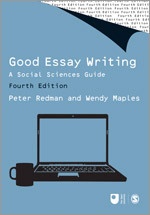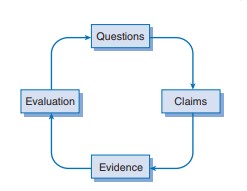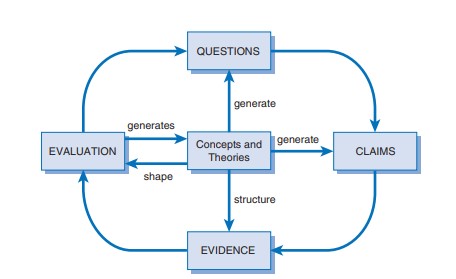What is a Social Science Essay?

[Ed. – We present this article, adapted from a chapter of Good Essay Writing: A Social Sciences Guide, as a resource for Academic Writing Month.]
There are different types of social science essay, and essays of different lengths require slightly different approaches (these will be addressed later). However, all social science essays share a basic structure which is common to many academic subject areas. At its simplest, a social science essay looks something like this:
Title | Every essay should begin with the title written out in full. In some cases this will simply be the set question or statement for discussion.
Introduction | The introduction tells the reader what the essay is about.
Main section | The main section, or ‘body’, of the essay develops the key points of the argument in a ‘logical progression’. It uses evidence from research studies (empirical evidence) and theoretical arguments to support these points.
Conclusion | The conclusion reassesses the arguments presented in the main section in order to make a final statement in answer to the question.
List of references | This lists full details of the publications referred to in the text.

What is distinctive about a social science essay?
As you are no doubt aware, essay writing is a common feature of undergraduate study in many different subjects. What, then, is distinctive about essay writing in the social sciences? There are particular features that characterize social science essays and that relate to what is called the epistemological underpinning of work in this area (that is, to ideas about what constitutes valid social scientific knowledge and where this comes from). Among the most important of these characteristics are:
• the requirement that you support arguments with evidence, particularly evidence that is the product of systematic and rigorous research;
• the use of theory to build explanations about how the social world works.
Evidence is important in social scientific writing because it is used to support or query beliefs, propositions or hypotheses about the social world. Let’s take an example. A social scientist may ask: ‘Does prison work?’ This forms an initial question, but one that is too vague to explore as it stands. (This question might be about whether prison ‘works’ for offenders, in terms of providing rehabilitation, or re-education; or it might be about whether it ‘works’ for victims of crime who may wish to see retribution – or any number of other issues.) To answer the question in mind, the social scientist will need to formulate a more specific claim, one that can be systematically and rigorously explored. Such a claim could be formulated in the following terms:

(Source: Sherratt et al., 2000, p. 18.)
‘Imprisonment reduces the likelihood of subsequent reoffending’. This claim can now be subjected to systematic research. In other words, the social scientist will gather evidence for and against this claim, evidence that she or he will seek to interpret or evaluate. This process of evaluation will tend to support or refute the original claim, but it may be inconclusive, and/or it may generate further questions. Together, these processes of enquiry can be described as forming a ‘circuit of social scientific knowledge’. This circuit can be represented as in this figure.
Undergraduates may sometimes be asked to conduct their own small-scale research, for instance a small number of interviews, or some content analysis. However, the focus of social science study at undergraduate level, and particularly in the first two years of study, will be largely on the research of others. Generally, in preparing for writing your essays, the expectation will be that you will identify and evaluate evidence from existing research findings. However, the principle holds good: in writing social science essays you will need to find evidence for and against any claim, and you will need to evaluate that evidence.
Theory is important in social scientific writing because the theoretical orientation of the social scientist will tend to inform the types of question she or he asks, the specific claims tested, the ways in which evidence is identified and gathered, and the manner in which this evidence is interpreted and evaluated. In other words, the theoretical orientation of the social scientist is liable to impact upon the forms of knowledge she or he will produce.
Take, for example, the research question we asked above: ‘Does prison work?’ A pragmatic, policy-oriented social scientist may seek to answer this question by formulating a specific claim of the sort we identified, ‘Imprisonment reduces the likelihood of reoffending’. She or he may then gather evidence of reoffending rates among matched groups of convicted criminals, comparing those who were imprisoned with those who were given an alternative punishment such as forms of community service. Evidence that imprisonment did not produce significantly lower rates of reoffending than punishment in the community may then be interpreted as suggesting that prison does not work, or that it works only up to a point. However, another social scientist might look at the same research findings and come to a different conclusion, perhaps that the apparent failure of prison to reduce reoffending demonstrates that its primary purpose lies elsewhere. Indeed, more ‘critically’ oriented social scientists (for example, those informed by Marxism or the work of Michel Foucault) have sought to argue that the growth of prisons in the nineteenth century was part of wider social attempts to ‘discipline’, in particular, the working class.

The issue here is not whether these more ‘critical’ arguments are right or wrong but that a social scientist’s theoretical orientation will inform how she or he evaluates the available evidence. In fact, it is likely that a ‘critical’ social scientist of this sort would even have formulated a different research ‘claim’. For example, rather than seeking to test the claim, ‘Imprisonment reduces the likelihood of reoffending’, the critical social scientist might have sought to test the proposition, ‘Prisons are part of wider social strategies that aim to produce “disciplined” subjects’. The point for you to take away from this discussion is, then, that the theories we use shape the forms of social scientific knowledge we produce (see Figure 2).
[Figure 2] Concepts and theories shape, and are shaped by, the circuit of knowledge Source: Adapted from Sherratt et al., 2000, p. 18.There is considerable debate within the social sciences about the exact relationship between theory and evidence. To simplify somewhat, some social scientists tend to argue that evidence can be used to support or invalidate the claims investigated by research and thereby produce theoretical accounts of the social world that are more or less accurate. Other social scientists will tend to argue that our theoretical orientations (and the value judgements and taken-for-granted assumptions that they contain) shape the processes of social scientific enquiry itself, such that we can never claim to produce a straightforwardly ‘accurate’ account of the social world. Instead, they suggest that social scientific knowledge is always produced from a particular standpoint and will inevitably reflect its assumptions.
What you need to grasp is that essay writing in the social sciences is distinguished by its emphasis on: the use of researched evidence to support arguments and on theory as central to the process by which we build accounts of social worlds. Your own writing will need to engage with both elements.
Common errors in essays
Having identified what distinguishes a social science essay we can return to the more practical task of how to write one. This process is elaborated in the chapters that follow, but before getting into the details of this, we should think about what commonly goes wrong in essay writing.
Perhaps the most common mistakes in essay writing, all of which can have an impact on your marks, are:
• failure to answer the question;
• failure to write using your own words;
• poor use of social scientific skills (such as handling theory and evidence);
• poor structure;
• poor grammar, punctuation and spelling; and
• failure to observe the word limit (where this is specified).
Failing to answer the question sounds easy enough to avoid, but you might be surprised how easy it is to write a good answer to the wrong question. Most obviously, there is always the risk of misreading the question. However, it is frequently the case that questions will ‘index’ a wider debate and will want you to review and engage with this. Thus, you need to avoid the danger of understanding the question but failing to connect it to the debate and the body of literature to which the question refers. Equally, particularly on more advanced undergraduate courses, you are likely to be asked to work from an increasing range of sources. The dangers here include failing to select the most relevant material and failing to organize the material you have selected in a way that best fits the question. Therefore, make sure that you take time to read the question properly to ensure that you understand what is being asked. Next, think carefully about whether there is a debate that ‘lies behind’ the question. Then be sure to identify the material that addresses the question most fully.
Writing in your own words is crucial because this is the best way in which you can come to understand a topic, and the only way of demonstrating this understanding to your tutor. The important point to remember is that if you do plagiarize, your essay risks receiving a fail grade, and if you plagiarize repeatedly you risk further sanctions. You must therefore always put arguments in your own words except when you are quoting someone directly (in which case you must use the appropriate referencing conventions). The positive side of what might seem like a draconian rule is that you will remember better what you have put in your own words. This ensures that you will have the fullest possible understanding of your course. If there is an end-of-course exam, such an understanding will be a real asset.
Social science essays also need to demonstrate an effective use of social scientific skills. Perhaps the most obvious of these skills is the ability to deploy theory and evidence in an appropriate manner (as you saw in the previous section, this is what distinguishes social scientific essay writing). However, particularly as you move on to more advanced undergraduate courses, you should also keep in mind the need to demonstrate such things as confidence in handling social scientific concepts and vocabulary; an awareness of major debates, approaches and figures in your field; the ability to evaluate competing arguments; and an awareness of potential uncertainty, ambiguity and the limits of knowledge in your subject. These are important because they indicate your ability to work creatively with the tools of the social scientist’s trade.
An effective structure is important and pragmatic because it helps the person who marks your essay to understand what is going on. By contrast, a list of unconnected ideas and examples is likely to confuse, and will certainly fail to impress. The simplest way to avoid this is to follow the kind of essay writing conventions briefly outlined above and discussed in later chapters of this guide. Chapter 8, on the main body of the essay, is particularly relevant here, but you will also need to keep in mind the importance of a well-written introduction and conclusion to an effectively structured argument.
The ability to spell, punctuate and use grammar correctly is, generally speaking, something you are expected to have mastered prior to embarking on a degree-level course. This is really a matter of effective communication. While it is the content of your essay that will win you the most marks, you need to be able spell, punctuate and use grammar effectively in order to communicate what you have to say. Major problems in this area will inevitably hold down your marks, so if this is an issue in your work, it will be a good idea to seek further help.
Finally, observing the word limit is important – and, as you probably realize, more difficult than it sounds. The simplest advice is always to check whether there is a word limit and what this is, and then to be ruthless with yourself, focusing only on the material that is most pertinent to the question. If you find that you have written more words than is allowed, you will need to check for irrelevant discussions, examples, or even wordy sentence construction. Too few words may indicate that you haven’t provided the depth of discussion required, or that you have omitted essential points or evidence.
In the light of the above, we can identify four golden rules for effective social scientific essay writing.
Rule 1: Answer the question that is asked.
Rule 2: Write your answer in your own words.
Rule 3: Think about the content of your essay, being sure to demonstrate good social scientific skills.
Rule 4: Think about the structure of your essay, being sure to demonstrate good writing skills, and observing any word limit.
Why an essay is not a report, newspaper article or an exam answer
This section has mainly focused on what is distinctive about a social science essay, but there is something distinctive about essays in general that is worth keeping in mind. Many students come from professional backgrounds where report writing is a common form of communication. For other students a main source of information is newspapers or online websites. These are all legitimate forms of writing that serve useful purposes – but, apart from some of the content on academic websites, they just aren’t essays. There are exam conventions that make exam writing – even ‘essay style’ exams – different from essay writing.
In part, this is to do with ‘academic register’ or ‘voice’. Part of what you will develop as you become a stronger essay writer is a ‘voice’ that is your own, but that conforms to the conventions of academic practice. For social scientists, as we have noted above, this practice includes the use of evidence to support an argument and providing references that show where your ideas and evidence have come from. It also includes the ability to write with some confidence, using the vernacular – or language – of your subject area. Different forms of writing serve different purposes. The main purpose of academic writing is to develop and share knowledge and understanding. In some academic journals this can take the form of boisterous debate, with different academics fully and carefully defending, or arguing for, one position or another. For students of social science, however, there may be less at stake, but essays should nevertheless demonstrate knowledge and understanding of a particular issue or area. Conforming to some basic conventions around how to present ideas and arguments, helps us more easily to compare those ideas, just as conforming to the rules of a game makes it easier for one sports team to play against another: if one team is playing cricket and the other baseball, we will find there are similarities (both use bats, have innings, make runs), but there will also be lots of awkward differences. In the end, neither the players nor the spectators are likely to find it a very edifying experience. The following looks at other forms of serious writing that you may be familiar with, but that just aren’t cricket.
Report writing
Reports take a variety of forms, but typically involve: an up-front ‘executive summary’, a series of discussions, usually with numbered headings and subheadings. They are also likely to include ‘bullet points’ that capture an idea or argument in a succinct way. Professional reports may include evidence, arguments, recommendations and references. You may already have spotted some of the similarities with essays – and the crucial differences. Let’s begin with the similarities. Reports and essays both involve discussion, the use of evidence to support (or refute) a claim or argument, and a list of references. Both will have an introductory section, a main body and a conclusion. However, the differences are important. With the exception of very long essays (dissertations and the like), essays do not generally have numbered headings and subheadings. Nor do they have bullet points. They also don’t have executive summaries. And, with some notable exceptions (such as essays around areas of social policy perhaps), social science essays don’t usually require you to produce policy recommendations. The differences are significant, and are as much about style as they are about substance.
Journalistic writing
For many students, journalistic styles of writing are most familiar. Catchy headlines (or ‘titles’) are appealing, and newspapers’ to-the-point presentation may make for easier reading. News stories, however, follow a different set of requirements to essays – a different set of ‘golden rules’. In general, newspaper and website news articles foreground the ‘who, what, where, when and why’ of a story in the first paragraph. The most important information is despatched immediately, with the assumption that all readers will read the headline, most readers will read the first paragraph, and dwindling numbers will read the remainder of the article. Everyday newspaper articles often finish with a ‘whimper’ for this reason, and there may be no attempt to summarize findings or provide a conclusion at the end – that’s not the role of news journalists. (Though there is quite a different set of rules for ‘Op Ed’ or opinion pieces.) Student essays, by contrast, should be structured to be read from beginning to end. The introduction should serve to ‘outline’ or ‘signpost’ the main body of the essay, rather than cover everything in one fell swoop; the main body should proceed with a clear, coherent and logical argument that builds throughout; and the essay should end with a conclusion that ties the essay together.
Exam writing
Again, exam writing has similarities and differences with essay writing. Perhaps the main differences are these: under exam conditions, it is understood that you are writing at speed and that you may not communicate as effectively as in a planned essay; you will generally not be expected to provide references (though you may be expected to link clearly authors and ideas). Longer exam answers will need to include a short introduction and a conclusion, while short answers may omit these. Indeed, very short answers may not resemble essays at all as they may focus on factual knowledge or very brief points of comparison.


























































































